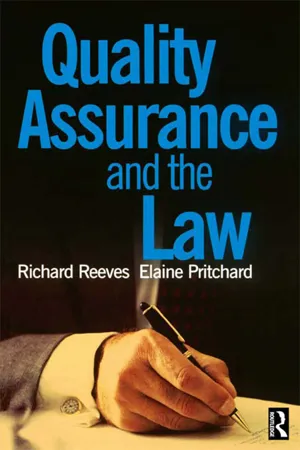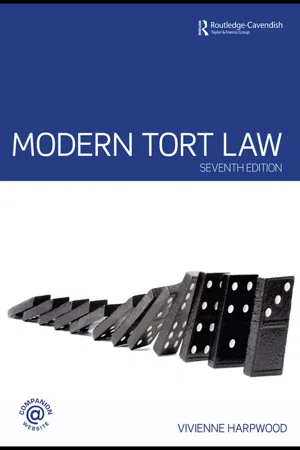Technology & Engineering
Consumer Protection Act 1987
The Consumer Protection Act 1987 is a UK law that provides protection to consumers in the event of product defects. It holds manufacturers, suppliers, and retailers responsible for ensuring that their products are safe for consumers to use. The act also allows consumers to seek compensation for damages caused by defective products.
Written by Perlego with AI-assistance
Related key terms
1 of 5
6 Key excerpts on "Consumer Protection Act 1987"
- eBook - ePub
- Elaine Pritchard, Richard Reeves(Authors)
- 2013(Publication Date)
- Routledge(Publisher)
Application of that section can be demonstrated by the following example. If (A) buys a new car, which unknown to him at the time, has a defective gear-box he would be able to hold both the car dealer (B) and the manufacturer of the defective gear-box liable for any injuries sustained as a result of the defect. If action was taken against (B) under the provisions of this section (B) would be able to escape liability by identifying the person who supplied him with the car. The identification of the manufacturer is not necessary. Again the importance of accurate record keeping cannot be over-emphasized. Persons who may be so affected should ensure records are kept of the suppliers of:1 the finished products,2 component parts, and3 raw materials and all dates of distribution or supply.The Consumer Protection Act 1987 – Part 2
Part 1 of the Act is concerned with civil liability and gives the injured party the right to sue one or more possible defendants, ensuring that persons suffering from personal injuries or damage to private property caused by a defective product will be compensated for their loss. The aim of Part 2 of the Act in particular was to prevent defective goods from reaching the market place in the first place. Section 10 of the Act which was concerned with the General Safety Requirement (GSR) has now been disapplied by the General Product Safety Regulations 1994. The remaining provisions of the Consumer Protection Act 1987 regarding the power to make safety regulations and issue notices is unaffected.For the most part it will be the safety requirement aspects of Part 2 which will give rise to the most immediate concern from the point of view of the quality of a product or service. As already stated, section 10 of the Consumer Protection Act 1987 was disapplied by the General Product Safety Regulations 1994, details of which can be found towards the end of this chapter.The Consumer Protection Act 1987 – Part 3
Whilst Parts 1 and 2 - eBook - ePub
- V.H. Harpwood(Author)
- 2009(Publication Date)
- Routledge-Cavendish(Publisher)
Any person in the chain of manufacture and distribution is potentially fully liable without proof of fault for any damage which is caused, wholly or partly, by the product.Liability is joint and several, which means that consumers have the option of suing all or any of the potential defendants. This overcomes many of the problems previously experienced by victims who were unable at common law to find or identify the defendant, particularly if that person or company had ceased to trade. Obvious targets for legal action under the Consumer Protection Act 1987 are the manufacturers or any person in the chain with good insurance cover, ‘deep pockets’ and the ability to pay substantial damages.15.4.3 Definition of a product
A ‘product’ is defined in s 2(1) of the Consumer Protection Act 1987 as:…any goods or electricity and (subject to subsection (3)) includes a product which is comprised in another product, whether by virtue of being a component part, raw material or otherwise.Goods are defined in s 45(1) as:…substances, growing crops, and things comprised in land by virtue of being attached to it and any ship, aircraft or vehicle.Damage which is caused by a break in the supply rather than a defect in the generation of electricity is not covered.The scope of this definition is not clear, and it remains to be seen whether it will be interpreted to include such things as computer programs which have been held to be ‘goods’ in another context (see St Albans CC v International Computers [1996] 4 All ER 481).Buildings as ‘immovables’ are not included in the definition, but building materials are, though defects in design and construction are not. Thus, if a part of a building collapsed through defects in the materials used, this could fall within the Consumer Protection Act 1987.Primary (unprocessed) agricultural produce and game was specifically excluded from the ambit of the Consumer Protection Act 1987. If it had undergone an industrial process to give it its essential characteristics, the produce was no longer ‘primary’ agricultural produce. This raised difficult questions as to what constitutes the industrial processing of agricultural produce. Clearly, eggs in their unchanged state were excluded, but if they were broken and mixed with other ingredients to make mayonnaise on a large or small scale, they probably fell within the Consumer Protection Act 1987 and there would be strict liability if they proved to be infected with salmonella. - Graham Stephenson(Author)
- 2022(Publication Date)
- Hart Publishing(Publisher)
Consumer Protection Act 1987 143 Consumer Protection Act 1987 (1987, c. 43) PART I PRODUCT LIABILITY 1. Purpose and construction of Part I (1) This Part was enacted for the purpose of making such provision as was necessary in order to comply with the product liability Directive and shall be construed accordingly .(2) In this Part, except in so far as the context otherwise requires— … ‘dependant’ and ‘relative’ have the same meaning as they have in, respectively, the Fatal Accidents Act 1976 and the Damages (Scotland) Act 1976; ‘producer’, in relation to a product, means— (a) the person who manufactured it; (b) in the case of a substance which has not been manufactured but has been won or abstracted, the person who won or abstracted it; (c) in the case of a product which has not been manufactured, won or abstracted but essential characteristics of which are attributable to an industrial or other process having been carried out (for example, in relation to agricultural produce), the person who carried out that process; ‘product’ means any goods or electricity and (subject to subsection (3) below) includes a product which is comprised in another product, whether by virtue of being a component part or raw material or otherwise; and ‘the product liability Directive’ means the Directive of the Council of the European Union, dated 25th July 1985, (No .85/374/EEC) on the approximation of the laws, regulations and administrative provisions of the member States concerning liability for defective products .(3) For the purposes of this Part a person who supplies any product in which products are comprised, whether by virtue of being component parts or raw materials or otherwise, shall not be treated by reason only of his supply of that product as supplying any of the products so comprised .2.- eBook - ePub
Safer by Design
A Guide to the Management and Law of Designing for Product Safety
- Howard Abbott, Mark Tyler(Authors)
- 2017(Publication Date)
- Taylor & Francis(Publisher)
An important provision is to be found in section 33, which is concerned with the discretionary exclusion of the time limit for actions in respect of personal injuries or death. If the court considers that it would be equitable to allow an action to proceed, the time limits provided for in the Act may be disregarded. It is difficult to predict the findings of the court as to its discretion, but the interests of individual consumers are often treated as outweighing the inconvenience to large companies having to face actions which have been initiated outside the normal three-year period.Special rules apply to strict liability actions brought under the Consumer Protection Act 1987. There is, in addition, a ‘long-stop’ for any liability: the claimant must bring his claim within ten years of the ‘relevant time’, which is defined as the time that the defendant supplied the product unless he is not the producer, own-brander or importer into the European Union. For persons not in one of these categories – for example, intermediate suppliers – the relevant time is when the product was last supplied by a person who does fall within these categories. In practice, these dates will be very difficult to identify and use against claimants unless careful records are kept.Other relevant legislationThere can be no one Act that governs design. The government formulates laws and regulations to deal with a product in the hands of the user; frequently legislation appears after a disaster has drawn attention to a defect. Design criteria are usually the province of standards bodies, professional societies and trade associations. In certain cases, safety regulations may be imposed on specific products by a Secretary of State under a relevant Act. A review of some of the Acts that can affect design must, therefore, be selective.The General Product Safety Regulations 1994
These Regulations, which implement the General Product Safety Directive (92/59/EEC) require a basic level of safety, termed the ‘general safety requirement’, for products intended for, or likely to be used by, consumers (see also Chapter 8 - eBook - PDF
Strength in Numbers
The Political Power of Weak Interests
- Gunnar Trumbull(Author)
- 2012(Publication Date)
- Harvard University Press(Publisher)
Britain’s early offi cial forays into consumer protection were tentative. The government’s first act in this sphere was the convening of the trade- and industry-dominated 1959 Molony Commission on Consumer Pro-tection, whose findings, unsurprisingly, emphasized the value of educa-tion and information as a tool of consumer protection. 61 Its main impact was the founding of the state-financed Consumer Council, established in 1963, to conduct research into the consumer interest and to represent that interest to the government. The council was restricted in important ways. Its statute blocked it both from conducting comparative product tests and from giving direct advice to consumers. It considered under-taking comparative price surveys, but balked at the expense and the po-tential political controversy such surveys might generate. The council did launch, in 1965, the “Teltag” system of quality labels for consumer goods. This strategy was modeled directly on the successful Swedish VKN labels. British producers never accepted the idea, however, and Teltag use was eventually limited to the tufted carpets market. 62 With growing uncertainty about its benefits, the Consumer Council was closed in 1970. In the wake of these policy failures, the 1970s marked a consumer protection renaissance in Britain, and a shift to a more aggressive regula-tory response. New legislative projects included the Trade Descriptions Act covering misleading advertising (1968), the Unsolicited Sales Act (1971), a small claims procedure (1972), the Supply of Goods Act impos-ing an implied warrantee on producers (1973), the Counter Inflation Act restricting price increases (1973), a Consumer Credit Act (1974), a Unit Pricing Act (1975), the Resale Prices Act banning retail price mainte-nance (1976), and an Unfair Contract Terms Act (1977). New government bodies were also created. In 1972, a Minister of Consumption was appointed to the Board of Trade. - eBook - ePub
- F R Roulston, M.O'C. Horgan, F.R. Roulston, F R Roulston **Decd**(Authors)
- 2003(Publication Date)
- Routledge(Publisher)
8: Quality assurance, reliability, the Limitation Acts, latent damage, strict liability and the Consumers Protection Act 1987, occupier’s risks and arbitration
It is a truism to say that engineering projects have recently changed: they always have changed, ever since man first made a spark by striking two stones together or watched a kettle boil; and they always will. However, it is safe to say that the changes which have taken place over the past few decades (possibly as the indirect result of two world wars) have been very considerable by any standards, and it is fitting that we should finish this book with a summary of the chief enactments have brought about by developments in people and things.The changes in engineering have been legion, and it is quite outside our terms of reference in this book to make any attempt at listing them. They have been caused partly by new and cheaper processes (automation and robotics, for example), new electronics (computers, digital systems, transistors instead of valves, and hosts of other developments in this electronic age), by new materials (such as silicons, plastics, aluminium, titanium, plastic sheeting, oils and chemicals, detergents, etc.) and by the emergence of backward nations, self-government, the spread of industry, growing export trade, and such like. We have also experienced the world getting ‘smaller’, with international competition and the formation of international groups. These have caused us to look less parochially beyond our own country and defer to the ways and thoughts of others (e.g. the EEC or various trade pacts, etc.).All in all, we have to take a new look at the classic ways we have so conservatively followed for so long, and perhaps realize today that we must take far greater account of the liking that modern man has for legal assistance against personal affronts. Therefore, in this chapter we shall take a brief look at the different ways in which modern engineering is moving and the laws which have been made to cater for it. So far we have dealt with the more classic case, which all practitioners must master; now we examine more recent developments, which colour the end-product, and the route taken to get there.
Index pages curate the most relevant extracts from our library of academic textbooks. They’ve been created using an in-house natural language model (NLM), each adding context and meaning to key research topics.





